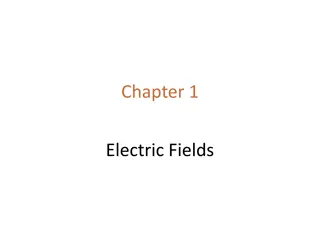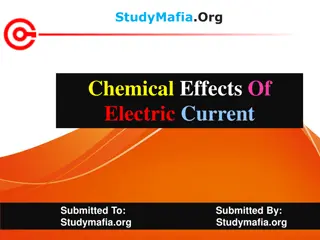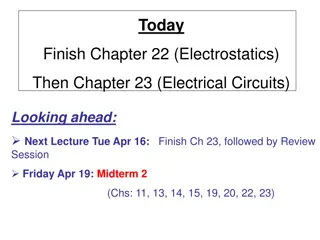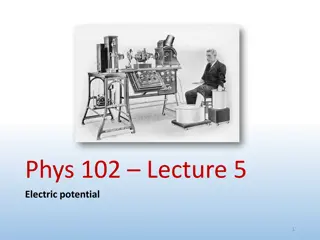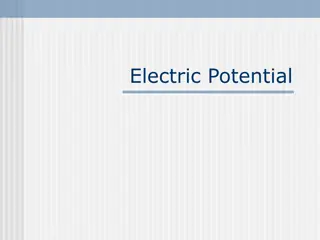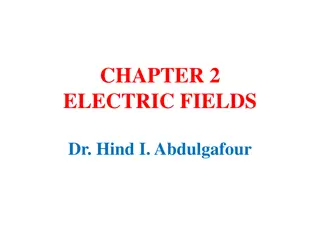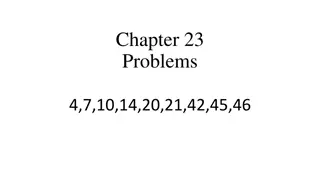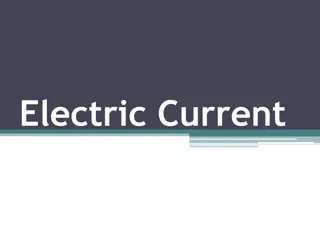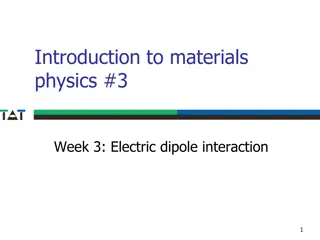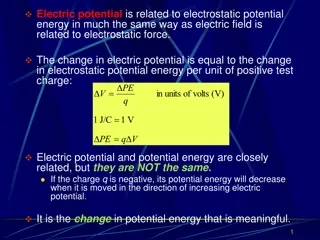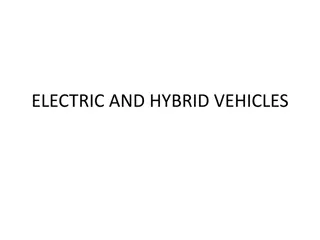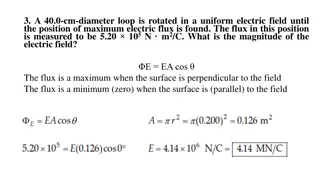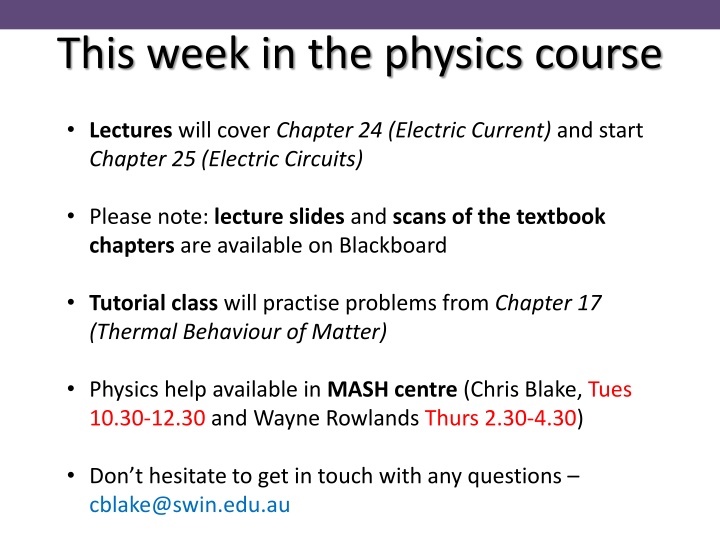
Electric Current Concepts: Chapters 24 and 25 Overview
This week in the physics course focuses on Chapters 24 and 25 covering Electric Current and Electric Circuits. Topics include defining current, Ohm's law, resistance, and electrical power. The direction of current flow, flow of charge, and creating an electric current are explained. Lecture slides and textbook scans are available for reference. Tutorial sessions will reinforce problem-solving skills related to thermal behavior of matter. Additional physics help is accessible in the MASH center. Explore these fundamental concepts through the provided resources.
Download Presentation

Please find below an Image/Link to download the presentation.
The content on the website is provided AS IS for your information and personal use only. It may not be sold, licensed, or shared on other websites without obtaining consent from the author. If you encounter any issues during the download, it is possible that the publisher has removed the file from their server.
You are allowed to download the files provided on this website for personal or commercial use, subject to the condition that they are used lawfully. All files are the property of their respective owners.
The content on the website is provided AS IS for your information and personal use only. It may not be sold, licensed, or shared on other websites without obtaining consent from the author.
E N D
Presentation Transcript
This week in the physics course Lectures will cover Chapter 24 (Electric Current) and start Chapter 25 (Electric Circuits) Please note: lecture slides and scans of the textbook chapters are available on Blackboard Tutorial class will practise problems from Chapter 17 (Thermal Behaviour of Matter) Physics help available in MASH centre (Chris Blake, Tues 10.30-12.30 and Wayne Rowlands Thurs 2.30-4.30) Don t hesitate to get in touch with any questions cblake@swin.edu.au
Chapter 22 summary Electric potential difference V is the work done when moving unit charge: ? = ?? The electric field is the gradient of the potential: ? = ?/ ? Charges feel a force from high electric potential to low potential
Chapter 24 : Electric current How do we define current? Macroscopic and microscopic description of current Ohm s law and resistance Electrical power
Electric current A flow of charge is called an electric current
Electric current A flow of charge is called an electric current The current (symbol I) is the amount of charge Q [in Coulombs] flowing per unit time t [in seconds] ? =? ? The units of current are C/s or Amperes A 1 ? = 1 ?/?
Electric current Current is in the direction that positive charge flows But in reality, current is transported by an opposite flow of negatively-charged electrons Sometimes described as conventional current (positive) or electron current (negative)
I In which wire(s) are there electrons moving from right to left? X electron current Y conventional current Z 1. Z only 2. X only 3. Y only 4. X and Y 5. Y and Z 6. X, Y and Z 0% 0% 0% 0% 0% 0% 1 2 3 4 5 6
Electric current How do we create an electric current? Create an electric potential difference between two points Connect those points to allow charge to flow Circuit symbols! Dissipate the energy (e.g. into light, heat)
Only one terminal of the battery is connected to the light bulb. What happens? 1. No current flows 2. A very small current flows 3. A current flows for only a short time 4. Current flows at half the rate it flowed with two wires 0% 0% 0% 0% 1 2 3 4
Electric current Electrical power may be supplied as either a direct current or an alternating current We will only cover direct current in this topic
Macroscopic vs. Microscopic In physics and chemistry we try and relate the overall macroscopic properties of a system to its microscopic nature
Microscopic nature of current What really happens when a battery is connected? (1) As we saw in the temperature topic, particles are in constant thermal motion +q +q +q +q +q +q +q +q +q +q +q
Microscopic nature of current What really happens when a battery is connected? (2) The battery supplies a potential difference hence electric field E +q +q +q +q +q +q +q +q +q +q +q
Microscopic nature of current What really happens when a battery is connected? (3) The charges feel a force from the electric field and start to accelerate E +q +q +q +q +q +q +q +q +q +q +q
Microscopic nature of current What really happens when a battery is connected? (4) The charges undergo collisions with the other particles in the material which slows their motion E +q
Microscopic nature of current What really happens when a battery is connected? (5) These collisions produce a resistance to motion which results in an equilibrium drift velocity
Microscopic nature of current What really happens when a battery is connected? (5) These collisions produce a resistance to motion which results in an equilibrium drift velocity
Microscopic nature of current How much current is produced by drift velocity v? x How much charge Q flows through the area A in time t? v +q It s contained with a length x where x = v t , which means a volume V = A x = A v t A v +q v +q So, charge Q = q n V = q n A v t Number density of charges = n ? ?= ? ? ? ? Current ? =
Microscopic nature of current Exercise: A 5-A current flows in a copper wire with cross- sectional area 1 mm2, carried by electrons with number density 1.1 x 1029 m-3. What is the electron drift speed? ? = ? ? ? ? ? = 5 ? ? = 1.6 10 19 ? ? = 1.1 1029 ? 3 ? = 1 ??2= 10 6 ?2 ? 5 ? = ? ? ?= (1.6 10 19) (1.1 1029) (10 6)= 0.28 ??/? Isn t this incredibly slow? Yes but the electric field itself is established at the speed of light.
Microscopic nature of current The current density (symbol J) is the current flowing per unit area ( concentration of current ) ? =? ?= ??? The units of J are A/m2 Used in a microscopic description of current
Ohms Law : macroscopic version Ohm s law describes the resistance of a material to the flow of current (or its inverse conductance) ? =? ? ? = ?? The greater the resistance, the less current can flow for a given potential difference Resistance is measured in units of Ohms (symbol: )
Ohms Law : electrical shock Current of only 100 mA can be fatal to humans Luckily, resistance between points on human skin = 105 So, fatal voltage = V = I R = 0.1 x 105 = 10,000 V If skin is wet, resistance is reduced. Be careful!
Ohms Law : microscopic version The current density J flowing for a given electric field E depends on the resistivity ? of the material (or its inverse conductivity ? = 1/?) ? =? High resistivity ? means low current! ?= ? ?
Ohms Law : lie detection Sweat increases the conductance of the skin, which will change the current flowing for fixed voltage machines do detect deception better than chance, but with significant error rates
Ohms Law : microscopic version Exercise: A 1.8-mm diameter copper wire carries 15 A to a household appliance. What is the electric field in the wire? The resistivity of copper is 1.68 10 8 ?. Ohm s Law : ? = ?/? Resistivity of copper : ? = 1.68 10 8 ? ? ?= ? 15 ? (0.9 10 3)2= 5.9 106 ? ? 2 Current density ? = ? ?2= Electric field : ? = ? ? = 5.9 106 1.68 10 8= 0.099 ?/?
Ohms Law : microscopic version Exercise: A copper wire 0.5 cm in diameter and 70 cm long connects your car s battery to the starter motor. What s the wire s resistance? The resistivity of copper is 1.68 10 8 ?. ? = ?/? ? = ?/? ? = ?/? ? = ?/? current ? ? ? =1.68 10 8 0.7 ? (0.0025)2 ? =? ? ?=? ? =? ? = 6 10 4 ? ? Exercise: If the starter motor draws a current of 170 A, what s the potential difference across the wire? = 170 6 10 4= 0.1 ? ? = ? ?
Macroscopic vs. Microscopic Current density J driven by electric field E Current I driven by potential difference V Experiences resistivity ? Experiences resistance R Ohm s law ? = ?/? Ohm s law ? = ?/?
Electric current Current can be measured using an ammeter
Two electrical measuring devices, X and Y, are placed in the circuit as shown to measure properties of the resistor. Which of the following descriptions is correct? X Y 1. X measures current, Y measures voltage 2. X measures voltage, Y measures current 3. X and Y measure current 4. X and Y measure voltage 0% 0% 0% 0% 1 2 3 4 Current is measured at a location Current is measured at a location ammeters in series. Voltage (potential difference) between two locations Voltage (potential difference) between two locations voltmeters in parallel.
How does the current entering the resistor, I1, compare to the current leaving the resistor, I2? I1 I2 1. I1 < I2 2. I1 > I2 3. I1 = I2 0% 0% 0% 1 2 3 CHARGE CONSERVATION: charge cannot be created or destroyed. Energy is dissipated as current flows through a resistance, but charge is conserved, so current in = current out.
Electric power Power is the rate of use of energy : ????? =?????? ???? How much power does an electric circuit consume? Moving charge Q across a potential difference V requires work : ? = ? ? (from last chapter) Power = ???? ????=? ? ? = I V (in terms of current I = Q/t) Using Ohm s law V = I R : Power = V I = I2R = V2/R
Electric power This power is dissipated as heat energy in the resistance why electrical components get hot!
Electric power Power is measured in Watts (1 W = 1 J/s) Your power bill is probably measured in kWh or kilo-Watt hours This is really an energy bill 1 kWh = 1000 J/s x 3600 s = 3.6 x 106 J = 3.6 MJ
Electric power Why do power lines operate at 100,000 V? P = V I : high power can be delivered using high V or high I Some power will be lost in heating the transmission wires P = I2R : low current minimizes these transmission losses
Electric power Exercise: What is the resistance of a 60 W 240V light bulb? ? = ? ? ? =? 60 240= 0.25 ? Power P = 60 W Voltage V = 240 V ?= ? = ? ? ? =? ?=240 0.25= 960 Exercise: What would be the power output if the bulb was plugged into the US mains of 110 V? ? = ? ? =?2 ?=1102 960= 12 ?
Thermal runaway and fuses For most conductors, resistance is not completely constant, but increases with increasing temperature. If part of a circuit starts to overheat, its resistance can increase, causing larger power dissipation, causing higher resistance etc. A fuse fuse protects a circuit from general damage by acting as the weak point ; a thin wire that will physically fail (melt) if current exceeds a safe level. Circuit breakers or safety switches either mechanical or electronic, are now able to offer faster and more reliable protection.
Chapter 24 summary Electric current is the rate of flow of charge measured in Amperes: ? = ?/? Microscopically charges q have a drift velocity v such that ? = ????[A=area, n=number density] Ohm s law relates the current to a resistance R (? = ?/?) or resistivity ? (? = ?/?) Electric current dissipates power P = V I




